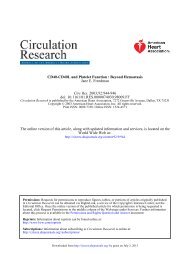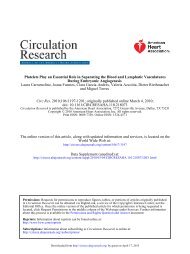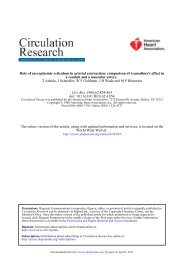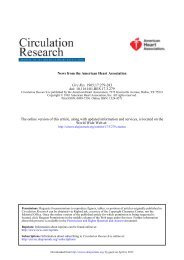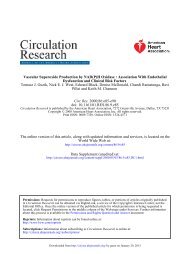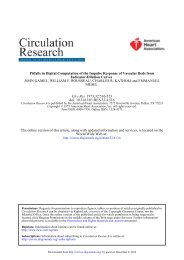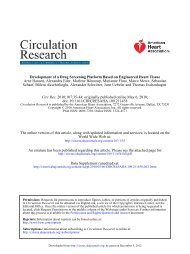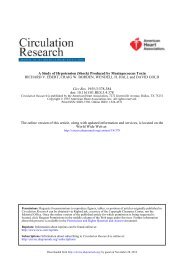Tetralogy of Fallot and Alterations in Vascular Endothelial Growth ...
Tetralogy of Fallot and Alterations in Vascular Endothelial Growth ...
Tetralogy of Fallot and Alterations in Vascular Endothelial Growth ...
You also want an ePaper? Increase the reach of your titles
YUMPU automatically turns print PDFs into web optimized ePapers that Google loves.
the subpulmonary myocardium. In the Vegf120/120 embryos,<br />
only the soluble VEGF120 is<strong>of</strong>orm is expressed. This could<br />
<strong>in</strong>itially result <strong>in</strong> decreased signal<strong>in</strong>g followed by altered<br />
feedback mechanisms <strong>in</strong> Vegf expression, which then lead to<br />
the extreme <strong>in</strong>crease <strong>of</strong> Vegf120 levels (Figures 3c <strong>and</strong> 4e).<br />
However, as little is known about feedback mechanisms<br />
regulat<strong>in</strong>g Vegf expression, this rema<strong>in</strong>s elusive at this po<strong>in</strong>t.<br />
VEGF <strong>and</strong> Notch Signal<strong>in</strong>g <strong>in</strong> Abnormal<br />
Cushion Development<br />
VEGF signal<strong>in</strong>g has been described to play a role <strong>in</strong> OFT<br />
cushion development. 10–13 Although these processes largely<br />
take place before E10.5, we still f<strong>in</strong>d expression levels <strong>of</strong><br />
VEGF <strong>and</strong> VEGFR-2 <strong>in</strong> the endocardium <strong>and</strong> the mesenchyme<br />
<strong>of</strong> the OFT cushions <strong>of</strong> normal embryos (Figure 5a,<br />
5b, 5e, <strong>and</strong> 5f) <strong>and</strong> favor a role <strong>of</strong> VEGF signal<strong>in</strong>g <strong>in</strong> cushion<br />
expansion as well. VEGF has been reported to <strong>in</strong>crease<br />
Notch1 expression, 18,19 which, <strong>in</strong> turn, stimulates endocardial<br />
EMT. 13,23,26 In agreement with the low VEGF/VEGFR-2<br />
Figure 4. Vegf mRNA expression patterns <strong>in</strong> wild-type <strong>and</strong><br />
Vegf120/120 embryonic hearts. All sections show Vegf mRNA<br />
expression us<strong>in</strong>g radioactive <strong>in</strong> situ hybridization. Wild-type <strong>and</strong><br />
Vegf120/120 are compared as <strong>in</strong>dicated <strong>in</strong> the upper left corner,<br />
together with age. At E10.5, an <strong>in</strong>crease <strong>in</strong> endocardial Vegf<br />
mRNA expression was found <strong>in</strong> the OFT (compare arrows <strong>in</strong> a<br />
<strong>and</strong> d), whereas myocardial expression was comparable<br />
between genotypes. At E14.5, an <strong>in</strong>crease <strong>in</strong> Vegf mRNA<br />
expression was seen <strong>in</strong> the subpulmonary myocardium (b <strong>and</strong><br />
e). At E18.5, an <strong>in</strong>crease <strong>in</strong> expression <strong>of</strong> Vegf mRNA was found<br />
between the compact myocardium (CM) <strong>and</strong> the trabecular<br />
myocardium <strong>of</strong> the mutant embryos (compare f <strong>and</strong> c). A <strong>in</strong>dicates<br />
ascend<strong>in</strong>g aorta; LV, left ventricle; P, pulmonary trunk.<br />
Scale bar: 60 �mol/L (a <strong>and</strong> d); 200 �mol/L (b, c, e, <strong>and</strong> f).<br />
Van den Akker et al VEGF <strong>and</strong> Notch <strong>in</strong> TOF Development 5<br />
Figure 3. Vegf mRNA distribution <strong>in</strong><br />
wild-type <strong>and</strong> Vegf120/120 embryonic<br />
hearts. In hearts <strong>of</strong> wild-type embryos <strong>of</strong><br />
E14.5, E16.5, <strong>and</strong> E18.5, Vegf is<strong>of</strong>orm–<br />
specific quantitative PCR shows that the<br />
Vegf164 is<strong>of</strong>orm is most abundantly<br />
present (a), whereas the Vegf120 is<strong>of</strong>orm<br />
is least present. No significant differences<br />
are found <strong>in</strong> total Vegf mRNA<br />
levels (b), but the expression levels <strong>of</strong><br />
Vegf120 is<strong>of</strong>orm are significantly elevated<br />
<strong>in</strong> mutant as compared with wildtype<br />
embryos (c). *P�0.05.<br />
levels, Notch1 was weakly present <strong>in</strong> wild-type OFT endocardium<br />
<strong>of</strong> E10.5. In contrast, the Vegf120/120 mutants <strong>of</strong><br />
this age showed ectopic Vegf expression <strong>and</strong> <strong>in</strong>creased<br />
VEGF/VEGFR-2 prote<strong>in</strong> levels for the OFT endocardium. A<br />
high Notch1 <strong>and</strong> cleaved (activated) Notch1 expression was<br />
also observed <strong>in</strong> the cushion endocardium as well as <strong>in</strong> the<br />
mesenchyme <strong>of</strong> these embryos. These data imply that<br />
VEGF 40 <strong>and</strong> subsequent Notch signal<strong>in</strong>g is disturbed <strong>in</strong> the<br />
mutant <strong>and</strong> seems to be prolonged. Potentially, these disturbances<br />
will exert an effect on cushion EMT <strong>and</strong> could relate<br />
to OFT cushion hyperplasia <strong>and</strong> associated cardiac malformations<br />
as observed <strong>in</strong> the Vegf120/120 embryos.<br />
The positive effect <strong>of</strong> VEGF on cushion EMT <strong>in</strong> our model<br />
seems to contradict the f<strong>in</strong>d<strong>in</strong>g that myocardial overexpression<br />
<strong>of</strong> VEGF has an <strong>in</strong>hibit<strong>in</strong>g effect on atrioventricular<br />
endocardial cushion EMT <strong>and</strong> growth. 12 Functional differences<br />
between VEGF120 (as overexpressed <strong>in</strong> our mouse<br />
model) <strong>and</strong> the human VEGF165 (as used <strong>in</strong> research<br />
performed by Dor et al 12 ) might partially expla<strong>in</strong> these<br />
differences. Furthermore, <strong>in</strong> our research, the overexpression<br />
was observed <strong>in</strong> both the endothelium <strong>and</strong> myocardium <strong>of</strong> the<br />
OFT cushions, whereas no disturbed VEGF expression was<br />
apparent for the atrioventricular cushions. Moreover, our<br />
data, as well as earlier research us<strong>in</strong>g this mouse model, 5 do<br />
not present <strong>in</strong>flow anomalies. This difference between OFT<br />
<strong>and</strong> atrioventricular cushions implies a dist<strong>in</strong>ct function or<br />
sensitivity for VEGF <strong>in</strong> OFT versus atrioventricular cushion<br />
development <strong>and</strong> endothelial versus myocardial expression.<br />
Apoptosis <strong>of</strong> Subpulmonary Myocardium<br />
Colocalizes With Increased Notch Signal<strong>in</strong>g<br />
Dur<strong>in</strong>g mouse <strong>and</strong> chicken development, apoptosis <strong>of</strong> subaortic<br />
cardiomyocytes has been described as a normal phenomenon<br />
essential for proper OFT remodel<strong>in</strong>g. 39,41 In addition,<br />
it has been described <strong>in</strong> chicken embryos that<br />
aforementioned apoptosis is associated with hypoxia-<strong>in</strong>duced<br />
expression <strong>of</strong> VEGF. 39 In this research, we show that the<br />
subpulmonary Vegf expression co<strong>in</strong>cides with high phosphorylated<br />
VEGFR-2 <strong>and</strong> Jagged2 expression <strong>of</strong> cardiomyocytes.<br />
Although only a very small number <strong>of</strong> apoptotic cells is seen<br />
<strong>in</strong> the OFT myocardium <strong>of</strong> wild-type embryos, which is <strong>in</strong><br />
agreement with earlier observations, 41 Vegf120/120 mutants<br />
Downloaded from<br />
http://circres.ahajournals.org/ by guest on February 7, 2013




